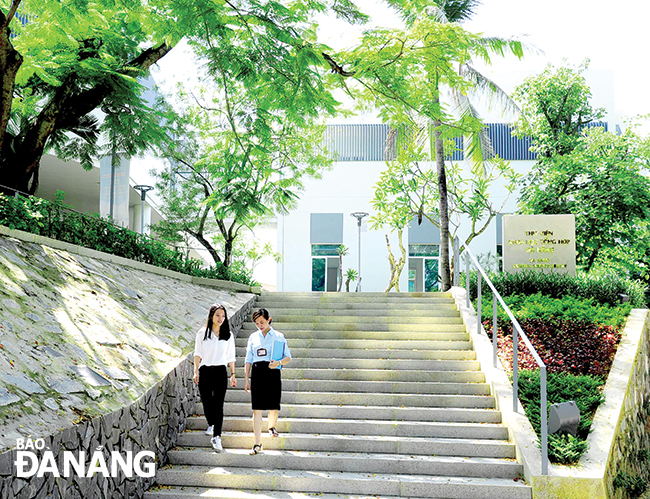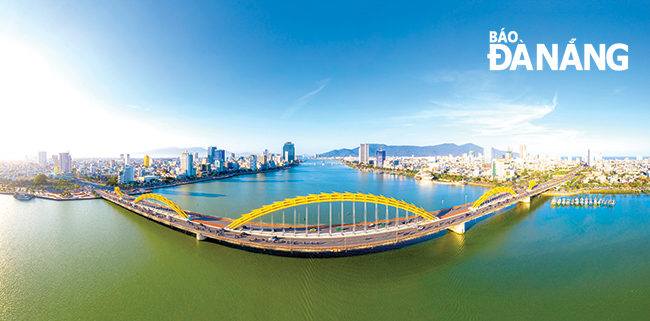Proposals for Da Nang to head towards an ideal city
Da Nang is endowed with beautiful nature, sea, rivers and mountains harmoniously combined into a beautiful terrain. Along with this natural advantage, focusing on building hardware and software infrastructure along with advocacy to build a cultural lifestyle of the citizens will easily make Da Nang an ideal city in the future.
 |
| A beautiful coastal urban corner of Da Nang. Photo: HUYNH VAN TRUYEN |
What are the conditions for an ideal city? The idealness must benefit the people living in Da Nang, and in the age of globalisation, friendliness towards foreign tourists should be given a special heed.
Hardware infrastructure
Let's talk about hardware infrastructure first. The construction of infrastructure is not only for the purpose of promoting economic development, but also to improve the living standards of the city dwellers, especially to create comfort, keep security and bring peace of mind to citizens and tourists.
Streets need to be wide and have sidewalks, trees and enough traffic signals. There is always a team in charge of cleaning to keep the street clean. Adequate investment should be made in the construction of parks, squares, hospitals and public libraries. These places are not only for the purpose of enhancing the landscape and creating an environment for people to exercise, entertain and play, but also a place of refuge in the event of natural disasters.
It is a need to build more standard public toilets in parks, at major bus stops, at major intersections. It is important to have someone who keeps the toilet clean every day, thus creating comfort for users. This is a necessary condition both to improve the living standards of urban residents and to create convenience for tourists.
Another target is how to make people not to worry about traffic accidents while traveling on streets. Especially, now in many cities, not only Da Nang, people's walking space is too little and unsafe. A city that is friendly to citizens and foreign tourists needs to have plenty of public transport and ensure safe access to them.
 |
| The Da Nang General Science Library. Photo: DANG NO |
One more point should be emphasised. Till date, the COVID-19 pandemic has basically been controlled, but in the future it may erupt again. Economic and social institutions need to be based on the premise of living with the pandemic. Population density must be lower than previously planned, and means of transport must be designed in the direction of social distancing.
To avoid crowding in buses or trains, people should be encouraged to travel by bicycle. Travelling by bicycle also contributes reducing air pollution in the city. As the living standard of urban residents increases, especially the middle class will be larger, the number of people using cars will go up.
But if the streets are designed to be cyclist-friendly, it will encourage people to use bicycles within a few kilometers of travel from home to work instead of using private cars.
With regard to keeping security and increasing peace of mind for citizens, a Japanese experience is worth referencing. It's the ubiquitous presence of police stations known in Japanese as koban. Kobans are located everywhere, usually near tram stations, subway stations, bus stops, and more.
At most kobans, police officers are on duty around the clock. In addition to the main task of maintaining security in the area, the koban is also a place to give travel guidance for visitors, receive and return belongings and money that are intentionally left or dropped by road users. Because of this special and very effective function, many countries have established kobans in their countries.
In particular, Singapore several decades ago sent police officers to practice in the koban of Ginza, one of the main streets in Tokyo.
 |
| Bach Dang Street, Hai Chau District with a system of green trees creates a harmonious and ecological urban space. Photo: L.P.N |
Building urban culture
As for software, in terms of culture in building an ideal city, the following points should be emphasised.
Firstly, publicising and promoting a civilised lifestyle for urbanites. Everyone needs to have a sense of keeping the environment clean. Currently, in urban areas around the world, people are required when generating garbage by themselves to bring their garbage home, avoid littering in public places. In addition, cultural attitudes among the townspeople also add to the beauty of the city.
The readiness to greet each other in public and help each other when needed are good habits. The hospitality shown in the culture of the city dwellers, in the organisation and in the economic and social activities across the city is also an attraction for domestic and foreign tourists.
Regarding Da Nang as well as other cities in Viet Nam, in addition to keeping the harmony and increasing the beauty of the environment and the landscape, it is necessary to pay attention to the conditions for an ideal city to stand in the position of dwellers who normally live in urban areas. It's peace of mind and comfort.
In addition, it is a need to take measures, through education and publicity, to increase the sense of community of local residents.
 |
| Landscape on both sides of the Han River. Photo: H.T |
Second, one of the most important safety issues of urban residents today is related to traffic. It is necessary to encourage car and motorbike drivers to absolutely company with traffic laws, especially respect and give priority to pedestrians. Da Nang should take the lead in issuing a rule to penalise the behaviour of disrespecting pedestrians.
Thirdly, quickly handling producers relating to business, accommodation, marriage registration and medical services, with a friendly and public attitude, is one of the attractive factors of a city. If the country takes the lead in this administration reform, Da Nang will be chosen as a livable city.
If the above-mentioned suggestions are done, Da Nang will become a magnet for talented people, thereby drawing even more investors and businesses.
Hopefully, Da Nang will soon become the model of an ideal city in Viet Nam and Asia at large.
Reporting Prof. TRAN VAN THO – Translating by A.THU








